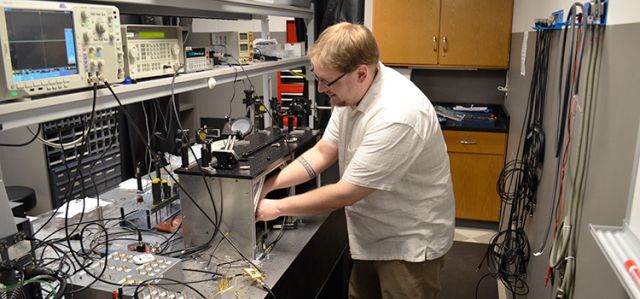Document Type
Article
Publication Date
6-2004
Publication Source
Optical Engineering
Abstract
Two advanced nondestructive evaluation systems are developed for imaging surface-breaking cracks in aerospace materials. The systems use scanning heterodyne interferometry and frequency-translated holography principles to image ultrasonic displacement fields on material surfaces with high resolution and sensitivity. Surface-breaking cracks are detected and characterized by visualizing near-field ultrasonic scattering processes, which in turn results in local intensification of ultrasonic displacement fields in the immediate vicinity of a crack. The local intensification permits cracks to be easily distinguished from background levels, and creates unique displacement field images that follow the contours and morphology of the cracks with microscopic precision. The interferometric and holographic imaging approaches each provide noncontact and near optical-diffraction-limited measurement capabilities that are essential for probing ultrasonic displacement fields in the immediate vicinity of cracks. Several representative crack-imaging results are provided, along with detailed descriptions of both experimental techniques, and the capabilities and limitations of each method. The resulting systems provide simple yet very powerful tools for evaluating surface-breaking cracks in detail.
Inclusive pages
1366-1374
ISBN/ISSN
0091-3286
Document Version
Published Version
Copyright
Copyright © 2004, Society of Photo Optical Instrumentation Engineers
Publisher
Society of Photo Optical Instrumentation Engineers
Volume
43
Issue
6
Peer Reviewed
yes
eCommons Citation
Blackshire, James Lawrence and Duncan, Bradley D., "Interferometric and Holographic Imaging of Surface-Breaking Cracks" (2004). Electro-Optics and Photonics Faculty Publications. 23.
https://ecommons.udayton.edu/eop_fac_pub/23




Comments
Paper is made available for download in compliance with publisher policy on self-archiving and with author permission. Permission documentation is on file.
One print or electronic copy may be made for personal use only. Systematic reproduction and distribution, duplication of any material in this paper for a fee or for commercial purposes, or modification of the content of the paper are prohibited.